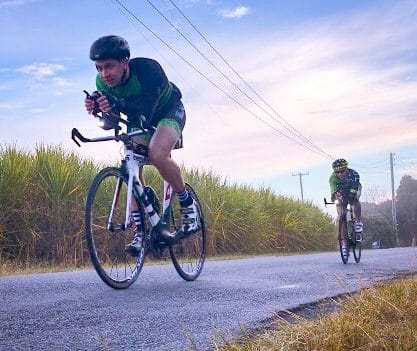In the world of triathlon, you will hear coaches, technical officials and staff talking about drafting. It can be confusing to know who and when you are allowed to draft, when you are forbidden to draft, and what the consequences are if you get it wrong. From beginners to veterans, there are questions, thoughts, and even long-held misconceptions about the topic of drafting. In this blog, we are going to briefly discuss what drafting is and what its role is in the sport of triathlon.
What is Drafting?
In simple terms, drafting is when you closely follow an athlete in front of you with the aims of reducing your effort while maintaining your speed. Drafting is a useful tactic if you want to save energy for another section of the course, or want to go a little bit faster than you would normally go but by keeping the same effort. Drafting can be done when swimming, cycling or running. Although it is on the ride where the advantages gained are the greatest.
Why Do People Draft?
Drafting brings many benefits, the main one is saving energy as there is less air/water drag in front of the athlete. This comes in handy if an athlete is feeling fatigue, wants to save energy or just wants to ride easier for a portion of the course.
When Can I Draft?
There are some athletes who are allowed to legally draft on the bike in certain race distances. In sprint and standard distance races you can draft on the bike leg in the elite, junior elite, and draft legal age group categories. In half, full, and ultra-distance events, drafting is illegal for all athletes.
Why is Drafting Illegal?
In triathlons, drafting is normally forbidden only on the cycling leg of the race. In the swim and on the run drafting is still a valid and perfectly legal strategy. It is forbidden on the ride because the difference is too big (up to 40%) for it to be fair in accordance with the spirit of the sport. You would be saving a big portion of energy by taking advantage of another athlete working much harder on the bike.
“To measure individual strength, speed, and endurance without taking advantage of other participants.” – (Part of.) The spirit of Triathlon.
How Do I Know if I’m Breaking the Rules?
The answer to this question varies in between events:
Ironman and Challenge events: The distance is 12 metres, and you will have 25 seconds to pass the rider in front of you if you decide to do so.
Triathlon Australia: The distance is 10 metres, and you will have 20 seconds to pass the rider in front of you if you decide to do so.
ITU Championships: There are some events that are draft-legal, that means that in these specific events and very specific age groups, drafting is allowed.
If you are just getting in the sport, the answer is easier than what you might imagine. To make sure that you are racing fairly and safely, you just need to picture a large car distance between you and the rider in front of you. If you think a large car could still fit between yourself and the athlete ahead, then you are within the laws of the sport. If you wish to pass that person, you will have around 20 seconds to get your front wheel in front of the front wheel of the rider in front. If you think you are too close, or you cannot pass the person within 20seconds, then the onus is on you to slow down and drop back to a legal distance behind.
Drafting rules can slightly change in some events, so it is always wise to ask the event organiser or Technical Officials about the rules for that specific race, and attend the race briefing before the start of the race.
What happens if I get caught drafting?
The penalties for being caught drafting change from race to race and depend on the organiser of the event. In most cases you will be shown a red card from someone on the back of a motorbike and will have to report to a penalty box. You will need to dismount in the penalty box and remain there from a few seconds to up to 5 minutes depending on the specific event.
Are the Any Exceptions to The Drafting Distances?
The answer is yes, there are many exceptions when you can get closer to the rider in front of you. These include:
- Safety reasons.
- On an aid station.
- Entrance or departure from a transition area.
- Making an acute turn.
Finally, the big lesson here is that drafting in an official race is cheating. When we say cheating, it not only means cheating the organisation, your team and your squad mates. Drafting is also cheating yourself. Drafting means not considering the hours you have put into your training, the early mornings and the late evenings training, the planning and studying your triathlon coach have put into your race goal and program.
If you want to read a little bit more about drafting rules and other aspects of triathlon, feel welcome to read the rules booklet by Triathlon Australia: 2020 RCR (triathlon.org.au)

